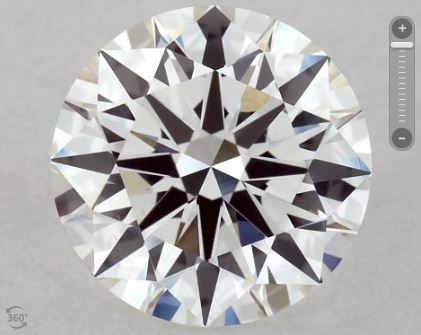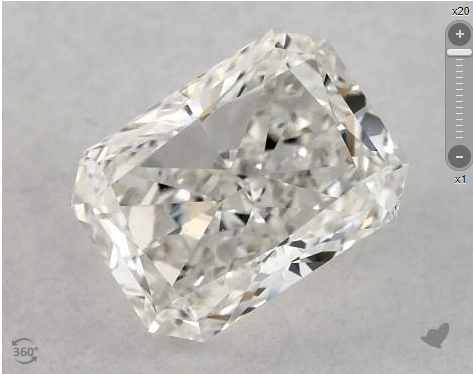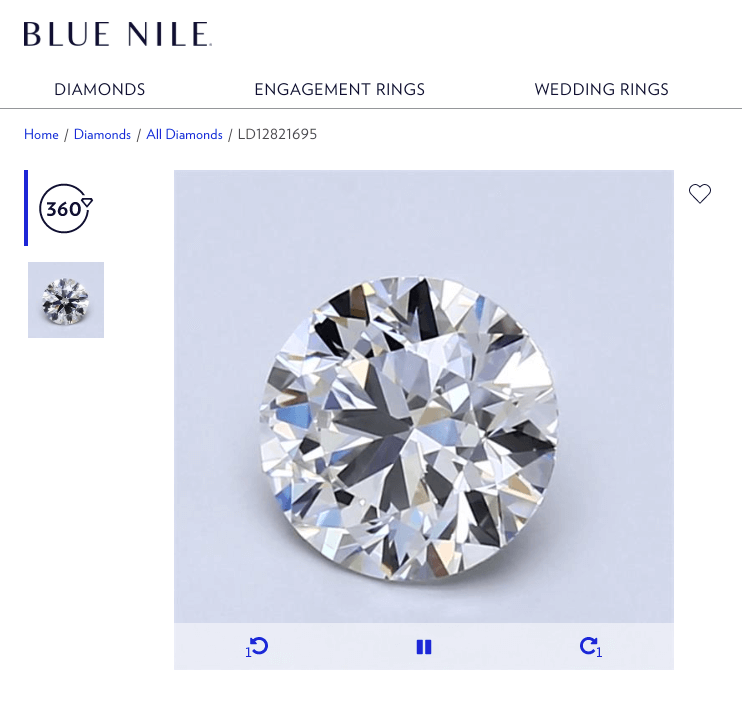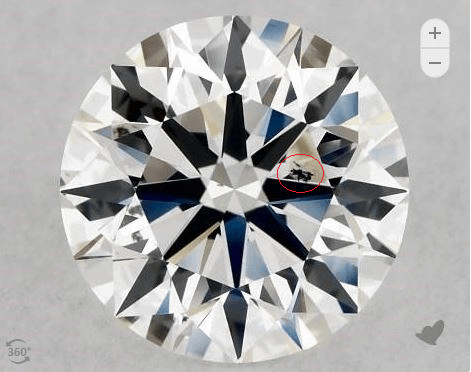Eye-clean diamonds are stones in which inclusions and blemishes are not visible to the naked eye when viewed from the top, or the “face-up” position. The term “eye-clean” is not an official grading; rather, it’s a subjective assessment that can vary from person to person based on their eyesight and the lighting conditions. When shopping for an eye-clean diamond, it’s crucial to ask for high-resolution images and 360-degree videos, as well as to view the diamond in person, if possible. Always scrutinize the stone under various lighting conditions to ensure it meets your eye-clean standards.
Be cautious of diamonds that are graded with lower clarity ratings, as they may contain inclusions visible without magnification, potentially affecting the diamond’s overall appearance and value. While opting for an eye-clean diamond could allow you to invest in a larger or better-colored stone, always prioritize a comprehensive understanding of the 4 Cs (cut, color, clarity, and carat) to make an educated purchase.
Knowing how to find an eye-clean diamond at a lower clarity grade—such as a VS2 or SI1 clarity—can save hundreds or thousands of dollars off of your engagement ring budget. You’ll pay less than you would for a flawless or almost flawless diamond but still get one that’s eye-clean. In the end, they look identical, and you’ll pay much less.
Learning how to spot an eye-clean diamond takes time—and knowing what to look for. You won’t be able to determine if a diamond is eye-clean from its certificate alone. You’ll have to evaluate each diamond more closely yourself.
“Natural diamonds are the result of carbon exposed to tremendous heat and pressure deep in the earth. This process can result in a variety of internal characteristics called ‘inclusions’ and external characteristics called ‘blemishes.’”
“No diamond is perfectly pure. But the closer it comes to purity, the better its clarity.” Gemological Institute of America (GIA)
Here’s what we’ll cover in this article:
What are eye-clean diamonds?
5 quick tips for finding an eye-clean diamond
What is the best clarity for an eye-clean diamond?
FAQs about eye-clean diamonds
Why you should trust us

What Are Eye-Clean Diamonds?
Eye-clean diamonds don’t have any inclusions and blemishes that are visible to the naked eye. Under magnification, they have imperfections, but not when you look at it without a jeweler’s loupe.
To see if a diamond is eye-clean, you need to look at it closely under HD photography or videography, like what’s provided by James Allen. When shopping in bricks and mortar stores, look at the diamond away from the overly bright sales lights. Ideally, you should review the diamond in natural daylight.

There isn’t a specific clarity grade that guarantees an eye-clean diamond. For instance, a VS2 doesn’t necessarily mean it’s eye-clean, but in many cases, it is, like in this Round Cut pave engagement ring from James Allen.
SI1 diamonds can be eye-clean, like this 1.00 Carat Radiant Cut diamond from James Allen. Even diamond with SI2 clarity can be eye-clean, but it’s less common. That’s why it’s so important to evaluate the clarity of the diamond yourself. The size, color and number of inclusions all impact the visibility of imperfections at the eye level.
5 Tips For Finding Eye-Clean Diamonds
Want to find an eye-clean diamond at the lowest price point? Follow these expert tips for your diamond search.
1. Check the clarity grade but understand that it’s not everything.
While the grade that the GIA or AGS gives out for clarity is important, it’s not the only tool you should use for evaluating a diamond. Generally, diamonds in the VS and SI ranges will give you the best value for an eye-clean diamond.
If it’s a VVS, FL or IF diamond, you’re paying too much for clarity (unless you’re going for a diamond over 3 carats, then a VVS might be your best value). These are the higher grades, and you can almost always find an eye-clean diamond for less. On the other hand, I1-I3 diamonds are simply too included to be eye-clean in any carat weight above 0.4ct.

For reference, the GIA grades clarity on the following scale:
- Flawless (FL)
- Internally Flawless (IF)
- Very Very Small Inclusions 1 (VVS1)
- Very Very Small Inclusions 2 (VVS2)
- Very Small Inclusions 1 (VS1)
- Very Small Inclusions 2 (VS2)
- Small Inclusions 1 (SI1)
- Small Inclusions 2 (SI2)
- Inclusions 1 (I1)
- Inclusions 2 (I2)
2. Look at the diamond closely.
Reputable online vendors like James Allen and Blue Nile provide high-quality, up-close imagery for every diamond in their inventory.
Review the photos and videos thoroughly to see if you notice any blemishes and inclusions. They offer the ability to zoom in and see where the inclusions are but remember you won’t be looking at the diamond under magnification when it’s in your ring.

If you’re shopping in-person, review the diamond in normal light—ideally daylight—to see if you notice any imperfections.
3. Note where the inclusions are.
Even if a diamond has blemishes and inclusions, you want to understand where they’re located. If they’re near the edge of the diamond, the ring setting is likely to cover them. If there’s a dark blemish in the middle of the diamond’s table, like in the diamond below, it won’t be covered. In fact, it’ll stand out each time you look at the diamond.

4. Aim for the lowest grade.
While a better clarity graded diamond might seem like the best choice, it isn’t worth the cost. A higher graded diamond will look identical to a lower graded diamond as long as they’re both eye-clean. For example, you can find diamonds like this beautiful SI2 on Blue Nile that saves you almost 18% over this VS2 one.
5. Ask for another pair of eyes.
t can be tough to evaluate a diamond’s clarity, especially if you’ve never done it before. Having an expert who’s reviewed thousands of diamonds can help you determine if it’s eye-clean. Reach out to us if you want us to take a look at some diamonds for you.
Best Clarity Grades For Eye-Clean Diamonds
The shape and carat weight of your diamond impact what clarity grade is most likely to be eye-clean. Follow these guidelines to get the most value.
Round Cut and Princess Cut: For 2 carat diamonds and smaller, VS2 and SI1 diamonds are almost always eye-clean (sometimes even SI2s for a round cut). For diamonds over 2 carats, VS1s and VS2s are eye-clean. When your carat weight gets over 3 carats, you may have to look at VVS2 diamonds to get an eye-clean stone. The bigger the diamond (carat weight can play a role), the easier it is to see imperfections.
Cushion Cut, Oval Cut, Radiant Cut, Marquise and Pear-Shaped: These diamond shapes hide inclusions better than others. Opt for an SI1 or SI2 for the best value.
Heart-Shaped: VS2 and SI1 heart shape diamonds will be eye-clean and offer you the most for your budget. They hide inclusions better than Round Cuts and Princess Cuts, but not as well as shapes like the cushion cut.
Emerald cut, asscher cut and baguette: It’s easier to see imperfections in step cut diamonds. Aim for a VS2 in these shapes for the best value.
FAQs About Eye-Clean Diamonds
Evaluating diamonds to get the best value takes time and research. Here we answer the top questions about eye-clean diamonds.
Almost all VS2 diamonds that are 1 carat or less are eye-clean (but you still can’t take this for granted). Diamonds between 1 and 2 carat are usually still eye-clean but you may have to jump up to a VS1. For diamonds over 2 carats, consider VS1 and even VVS2 diamonds for eye-clean stones.
I1 diamonds are generally not worth buying, especially for the center stone in an engagement ring, because there will be obvious inclusions. These inclusions and blemishes not only distract from the beauty of the stone, they also impact how well light travels through the diamond. Most I1 diamonds lack brilliance and fire.
For diamonds under 0.5 carat, such as the small stones in a pavé band, I1 clarity is a fine purchase. The diamonds are too small to see the imperfections, so you can save money by choosing I1 diamonds at this size vs. paying for a higher clarity grade.
The diamond inclusions that can be seen by the naked eye are the worst, and that usually involves inclusions that are particularly dark, large, or in the center of the diamond’s table. In some cases, a cluster of smaller inclusions will make the diamond appear cloudy.
There are many types of inclusions, from graining to feathers, but you need to review the diamond closely yourself to see if you can notice the imperfections without magnification.
Real diamonds can be cloudy (read more about cloudy diamonds here) if there are inclusions clustered together or if the diamond fluorescence is too strong. Real diamonds can also be cloudy if they have a build-up of grime and residue from normal wear. That’s why it’s important to care for your diamond engagement ring. Cleaning your ring regularly helps your diamond to look clear and to reflect light well (so it maintains its brilliance).
Eye-clean diamonds: Aim for the lowest clarity grade
Your goal with diamond clarity should be to find a stone that’s eye-clean. A low-graded eye-clean diamond looks identical to a flawless graded diamond assuming all else is equal—but will cost far less. To get the best value, look for an eye-clean diamond in the lowest grade.
For help finding an eye-clean diamond at the best price, send us a note.

- No questions asked returns within 30 days of shipment. James Allen will send you a paid shipping label to return the ring.
- Lifetime Warranty
- Free International Shipping
- Free prong tightening, repolishing, rhodium plating and cleaning every 6 months
- Provide insurance appraisals
- One free resizing within 60 days of purchase
- Free ring inscriptions
- Best-in-class high quality imagery of all diamonds in stock
- 24/7 Customer Service
- Best-in-class packaging


- No questions asked returns within 30 days of shipment. Blue Nile will send you a paid shipping label to return the ring.
- Lifetime Warranty
- Free Shipping
- Free prong tightening, repolishing, rhodium plating and cleaning every 6 months
- Provide insurance appraisal
- One free resizing within the first year of purchase
- High quality images of about half of their diamonds
- 24/7 Customer Service
- 100% credit towards future upgrades (must be at least double in value)
- Best in class fulfillment

Still afraid of getting ripped off?
Before you buy a diamond, get personal buying advice from industry veterans. We'll help you get the best diamond for the money.
Ask your diamond purchase question here
DISCLAIMER: We don't use your email for marketing. Period.
You Might Like
Diamond Prices: A Complete Guide
A diamonds’ price is determined primarily by the 4 Cs of the diamond. On the wholesale level, diamond prices are first based on a diamond shape and
The Best Places to Buy Engagement Rings
Buying an engagement ring is often one of the first major purchases in a person's life. The process can be fraught with tension as there are so m
1 Carat Diamond Price & Buying Guide
A wide range of 1 carat diamonds exist both in online markets and local diamond jewelry stores. Not only are there significant differences in beauty



